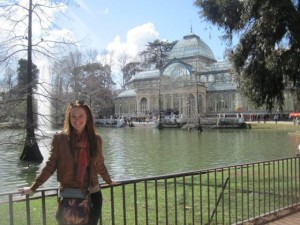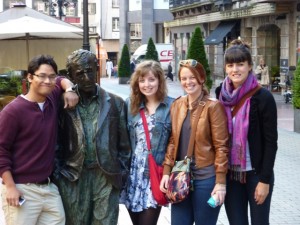
Shannon Cannizzaro ’12 in Madrid
Each time Shannon Cannizzaro ’12 (Verona, N.J.) looks at her favorite painting, Pablo Picasso’s Guernica, she notices something different. This spring, she had the chance to study the masterpiece depicting the bombing of the Basque city during the Spanish Civil War from only inches away.
Cannizzaro spent two weeks studying the art and culture of Spain through the Rothkopf Scholars program along with Hayley Trowbridge ’12 (Potomac, Md.), Christina Abruzzo ’12 (Summit, N.J.), and Ashutosh Tamrakar ’12 (Kathmandu, Nepal). The Rothkopf Scholars program is funded by an endowment established through gifts made to the Lafayette Leadership Campaign in honor of former Lafayette President Arthur J. Rothkopf ’55 and Barbara Sarnoff Rothkopf.
“It’s a completely different experience and, for me, it was a much more emotional connection being up close with these paintings,” says Cannizzaro. “I was already passionate about Spanish art, but having it at my disposal every day was truly a gift. You’re able to notice subtle nuances you wouldn’t notice otherwise.”
The students spent a whirlwind several weeks visiting some of the world’s most famous museums and sites in Madrid, Toledo, Oviedo, and Santiago de Compostela. In addition to visiting museums like the Museo del Prado, Thyssen-Bornemisza Museum of Art, Centro de Arte Reina Sofía, Museo Sorolla, Museo del Traje, and Museum of the Americas, they also toured the Cathedral of Santiago de Compostela and Mosque of Cristo de la Luz. Lynette Bosch, professor of art history at SUNY-Geneseo, and Charles Burroughs, interim chair of classics and Elsie B. Smith Professor of Liberal Arts at Case Western University, led the trip.

Ashutosh Tamrakar ’12, Hayley Trowbridge ’12, Shannon Cannizzaro ’12, and Christina Abruzzo ’12 with the statue of Woody Allen in Oviedo.
For Trowbridge, it was the spontaneous moments on the trip, like happening on the Puerta del Sol plaza in Madrid during economic protests or finding a special exhibit at the Thyssen, that made her time in Spain so memorable. The Thyssen’s Heroinas exhibit especially struck a chord.
“Seeing it threw me into this awestruck state for the rest of the day,” says the art and English double major. “I loved how the works, originating in different centuries, borrowed from art museums that spanned the globe, and quite distinct in their styles and mediums, told the inherently familiar and dynamic stories of the heroine, be she a mother, warrior, or goddess. It ended up being one of my favorite museum visits.”
Another highlight was the visit to Santiago de Compostela and meal in the parador, a government building converted into a hotel, that used to be the Royal Hospital for pilgrims who had completed their journey to the famous Roman Catholic church that holds the remains of St. James. The Rothkopf trip was a perfect segue for Cannizzaro, who spent the spring semester abroad in Spain as well. Even though she had visited many of the museums during the semester, seeing them again during the Rothkopf trip still taught her something new.

The students at Santiago de Compostela
“Being selected for the Rothkopf program definitely shows me how much more there is to learn about my majors,” says the Spanish and art double major, who plans to write her honors thesis on the earliest forms of protest art in Spain. “I thought I had a strong background in the art of Spain, but Lynnette and Charles had so much information to offer that it just made me even more passionate about this field. My art history classes over the semester started in the 16th century. On the Rothkopf program, Lynnette and Charles spoke to us about what was going on in Spain as early as the Middle Ages, giving us a very in-depth and solid background of the country’s history.”
Like Cannizzaro, Trowbridge was mesmerized by works of art she had only seen before in books or on a projection screen. In her classes at Lafayette, she studies a work’s history, the artist’s relationship with his patrons, symbolism, and even the types of brushstrokes, which allowed her to appreciate the pieces she saw more fully.
“To be within reach of the painting or sculpture or architectural masterpiece that we have spent hours studying, about which we have written pages, is to experience a new spark of enlightenment,” she says. “For me, it is the texture of the individual brushstrokes, the gleam of the light as it hits the oil, the ability to walk around the work, to kneel in order to examine the details that the classroom projection overlooks that make museum visits so special.”


